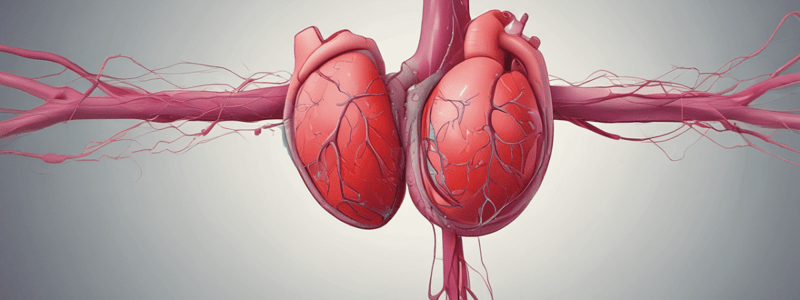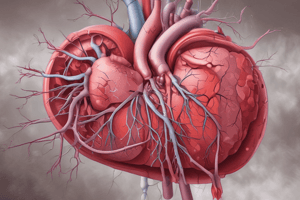Podcast
Questions and Answers
What percentage of acute pulmonary embolism originates from thrombi in the leg or pelvic veins?
What percentage of acute pulmonary embolism originates from thrombi in the leg or pelvic veins?
- 75%
- 80%
- 95% (correct)
- 100%
What is the outcome of massive pulmonary emboli?
What is the outcome of massive pulmonary emboli?
- Sudden death due to right ventricular failure (correct)
- Chronic pulmonary hypertension
- Reversible lung damage
- Mild symptoms and quick recovery
What happens to lung units in pulmonary embolism?
What happens to lung units in pulmonary embolism?
- They remain unaffected
- They increase carbon dioxide production
- They become deadspace units, reducing oxygenation (correct)
- They become more efficient at oxygen exchange
What is the effect of pulmonary embolism on right ventricular function?
What is the effect of pulmonary embolism on right ventricular function?
What is a common symptom of pulmonary embolism?
What is a common symptom of pulmonary embolism?
What is the effect of hypoxia on the body in pulmonary embolism?
What is the effect of hypoxia on the body in pulmonary embolism?
What is the primary characteristic of massive PE according to the American Heart Association?
What is the primary characteristic of massive PE according to the American Heart Association?
Which of the following is NOT a component of Virchow's triad?
Which of the following is NOT a component of Virchow's triad?
A patient presents with a systolic BP of 85 mmHg for 20 minutes and requires inotropic support. What category of PE would they most likely be classified as?
A patient presents with a systolic BP of 85 mmHg for 20 minutes and requires inotropic support. What category of PE would they most likely be classified as?
What is the primary difference between sub-massive PE and low-risk PE?
What is the primary difference between sub-massive PE and low-risk PE?
A patient has a chest CTA that shows right ventricular dilatation. What category of PE would they most likely be classified as?
A patient has a chest CTA that shows right ventricular dilatation. What category of PE would they most likely be classified as?
What is the primary mechanism by which leukocytic pyrogens reset the hypothalamic thermostat?
What is the primary mechanism by which leukocytic pyrogens reset the hypothalamic thermostat?
What is the effect of fever on the body's metabolic rate?
What is the effect of fever on the body's metabolic rate?
What is the primary symptom experienced by a patient before their core temperature reaches the new thermostat setting?
What is the primary symptom experienced by a patient before their core temperature reaches the new thermostat setting?
What is the primary reason for the hypothalamic thermostat reset during fever?
What is the primary reason for the hypothalamic thermostat reset during fever?
What is the effect of fever on the body's heat production and heat conservation mechanisms?
What is the effect of fever on the body's heat production and heat conservation mechanisms?
What occurs when the reason for the thermostat reset resolves?
What occurs when the reason for the thermostat reset resolves?
Which part of the brain contains neurons that respond to cold or warm stimuli?
Which part of the brain contains neurons that respond to cold or warm stimuli?
How does the body dissipate heat?
How does the body dissipate heat?
What is the normal variation in body temperature?
What is the normal variation in body temperature?
What is the effect of exercise on body temperature?
What is the effect of exercise on body temperature?
How long does it typically take for night shift workers to adjust to a day shift schedule?
How long does it typically take for night shift workers to adjust to a day shift schedule?
When do people who work during the day and sleep at night typically register their lowest body temperature?
When do people who work during the day and sleep at night typically register their lowest body temperature?
Flashcards are hidden until you start studying
Study Notes
Classifications of Pulmonary Embolism (PE)
- Massive PE: Characterized by sustained hypotension (systolic BP < 90 mmHg for at least 15 minutes) or inotropic support; may cause pulselessness or severe bradycardia (heart rate < 40 bpm) accompanied by shock symptoms.
- Sub-massive PE: Shows signs of right ventricular (RV) dysfunction, including RV dilatation on chest CTA, echocardiographic indicators, and biomarkers like troponin or pro-BNP indicating myocardial stretching.
- Low-risk PE: No evidence of RV dysfunction or laboratory indicators of strain.
Causes of Venous Thrombosis
- Virchow's Triad: Three key abnormalities leading to venous thrombosis:
- Hypercoagulability
- Stasis of venous blood flow
- Endothelial injury
Fever: Definition and Mechanism
- Definition: Body temperature maintained above normal, typically considered a fever if over 38.0°C (100.4°F) or 38.3°C (101°F).
- Causes: Often a sign of infection, but can be triggered by various factors, including leukocytic pyrogens which elevate the hypothalamic thermostat.
- Symptoms: Chills and shivering before reaching the new temperature set point; crisis occurs when the body temperature normalizes, leading to sweating.
Physiological Impact of Fever
- Increased Metabolic Rate: Fever elevates both CO2 production and oxygen consumption, leading to rapid, deeper breathing.
- Body Temperature Regulation: Hypothalamus monitors body temperature via core thermoreceptors and surface receptors. Heat loss or conservation regulated by blood flow changes and mechanisms like convection, conduction, and evaporation.
Natural Temperature Variations
- Normal Body Temperature: Generally averages 98.6°F (37°C), fluctuating by ±1°F based on circadian rhythm and menstrual cycle.
- Exercise Impact: Can raise body temperature by 2-3°C.
- Diurnal Pattern: Lowest body temperature typically between 3:00-6:00 A.M. gradually rising to peak around 8:00-11:00 P.M.
Signs and Symptoms of Pulmonary Embolism
- Deep Vein Thrombosis (DVT): Major source for venous thromboembolism (VTE) leading to PE, with 95% of acute cases originating from leg or pelvic vein thrombi.
- Acute PE: Results in RV failure when a large embolus obstructs the pulmonary arterial circulation; small emboli are usually asymptomatic.
- Symptoms of Massive PE: Can lead to sudden death; most diagnosed post-mortem.
- Symptoms of Sub-massive PE: Includes acute pulmonary arterial hypertension, RV dilation, right ventricular infarction, pleuritic chest pain, shortness of breath, and hypoxia; may also present with low-grade fever and hemoptysis.
Studying That Suits You
Use AI to generate personalized quizzes and flashcards to suit your learning preferences.




